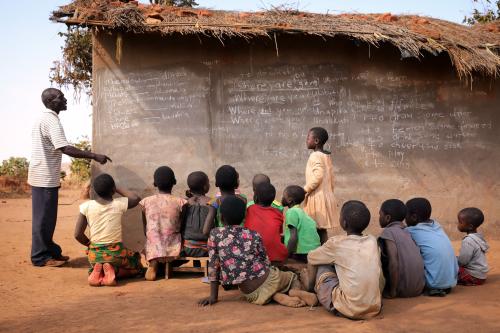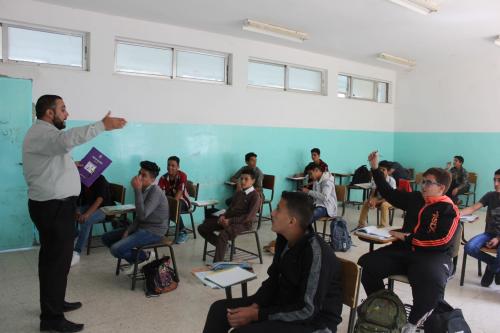Successful scaling of education initiatives requires the effective coordination and collaboration of many individuals. Among these individuals, experience and research show that champions of the initiative are essential, along with innovation originators, funders, policymakers, and practitioners. Champions can be leaders of NGOs, policymakers, teachers, and parent groups, and play a crucial role in increasing visibility, building political will, fostering support, mobilizing resources, and creating an enabling environment for scaling. Although there is ample literature on the role of champions in scaling, few examples illustrate how champions are identified, cultivated, and supported in practice.
Although there is ample literature on the role of champions in scaling, few examples illustrate how champions are identified, cultivated, and supported in practice.
Since 2017, Youth Impact has been partnering with the government of Botswana to implement a remedial education program, called Teaching at the Right Level (TaRL), with the aim of scaling TaRL to all public schools in the country. This partnership was not built overnight but was cultivated by passionate champions who invested time and resources into the program. Five strategies played an important role in helping to identify, cultivate, and maintain relationships with these core champions.
Strategy 1: Select champions based on their commitment to co-design the scaling plan
The Center for Universal Education’s (CUE) research on scaling education innovations for impact in low- and middle-income countries highlights the importance of engaging champions who see the value of the innovation. Youth Impact takes this one step further. They cultivate champions across multiple levels of the education system who are willing to invest their time into co-creation. This involves collaborative decision-making and asking what can be achieved together. The approach has been critical for sustaining champions’ interest and making TaRL a ministry-supported and mandated activity. For example, when expanding the program to Northeast and Northwest regions, Youth Impact shared what they could offer and asked what the regional government actors could bring to improve learning outcomes through TaRL. This co-creation approach has been critical for sustaining champions’ interest and scaling TaRL.
Strategy 2: Pursue a “follow the leader,” demand-driven approach to expanding to new regions
CUE’s previous research has emphasized the importance of engaging stakeholders in designing and implementing education innovations to ensure they meet local needs and are sustainable over time. Rather than pursue a solely top-down approach to scaling, Youth Impact has pursued a demand-driven approach, with a strong focus on expansion at the regional level. This has meant that Youth Impact expanded TaRL based on the presence of strong individual champions who were enthusiastic about bringing TaRL to their communities—what Youth Impact terms a “follow the leader” approach. For example, when a key early champion for TaRL moved from one region to another, Youth Impact “followed” that person to the new location to expand the implementation of TaRL. This approach closely attached TaRL to influential leaders and leveraged their skills, resources, and networks for scaling. It also helped maintain a close relationship between Youth Impact and the champions they had succeeded at cultivating. Regional champions also supported Youth Impact in selecting subsequent regions for expansion.
Strategy 3: Leverage existing champions to create new ones
With a few strong champions already on board for scaling TaRL, Youth Impact has succeeded at amplifying these connections to build a broader group of champions. Youth Impact benefitted from the fact that the Permanent Secretary connected Youth Impact with the Deputy Permanent Secretary of Education (DPS) who had independently become a champion of TaRL. As such, Youth Impact started the process of piloting and adapting TaRL in Botswana with a high-level government champion and partner. The DPS could then facilitate additional connections between Youth Impact and other key leaders, helping them gain access to and cultivate champions at the regional level. A similar process was utilized at the regional level, where Youth Impact relied on strong champions to help make the case for TaRL to more skeptical regional leaders through the power of “near-peer” relationships. Scaling literature has highlighted the benefits of leveraging existing champions to create new champions.
Strategy 4: Build enthusiasm through visible impact and real-time data
Using data in a way that is meaningful for stakeholders is important for building enthusiasm with champions. Youth Impact takes potential champions on site visits to see TaRL in action, observe student and teacher engagement, and hear directly from school heads and teachers who endorse the program. Youth Impact complements these visits by connecting the potential leaders to real-time impact data. Rapid and frequent data collection on student learning levels is a core element of the TaRL model, and new data is shared from schools to Youth Impact headquarters for analysis. These results are rapidly made accessible publicly on a digital dashboard, where champions and community stakeholders can see simple bar graphs demonstrating student improvement in reading and mathematics. Youth Impact also publishes and shares short reports on student improvement with government decisionmakers and other stakeholders. Youth Impact has connected the energy and excitement potential champions see in the school implementation to tangible positive learning outcomes, helping to build interest in the program and foster new national and local champions for scaling TaRL.
Strategy 5: Highlight how the innovation builds on existing teaching practices
One of the biggest challenges of scaling education initiatives is ensuring teachers support the innovation. Youth Impact has linked TaRL to pedagogical approaches teachers learned in their pre-service training but have not applied in their classrooms. In this way, teachers in Botswana have tended to view TaRL as a “refresher” to their existing knowledge and training. Framing TaRL as a familiar approach that builds on good practices from the past has been particularly effective for cultivating teachers and school leaders as champions. Similarly, TaRL’s use of cost-effective and simple learning materials like sticks and stones has been a strong selling point with potential champions. The use of local materials has tapped into the memories of teachers, school leaders, and political decisionmakers of how they learned at school themselves and has helped garner their support due to the low or no cost of locally sourced materials.
Successfully implementing changes in education systems involves the active support and genuine involvement of various stakeholders, from community members to national-level policymakers. Youth Impact’s journey to scale and sustain TaRL within Botswana’s education system illustrates how lessons from the scaling literature can be applied to scale education innovations in practice.
The Brookings Institution is committed to quality, independence, and impact.
We are supported by a diverse array of funders. In line with our values and policies, each Brookings publication represents the sole views of its author(s).









Commentary
5 strategies for cultivating champions to scale education initiatives
March 22, 2023